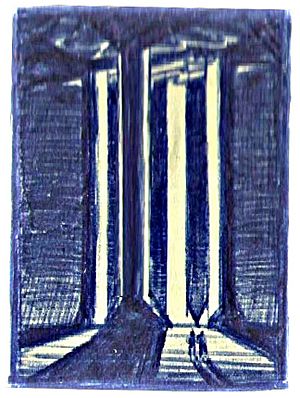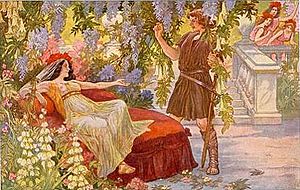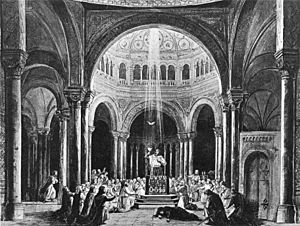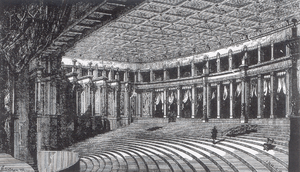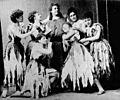Parsifal facts for kids
Parsifal is a famous opera by Richard Wagner. It has three acts. Wagner got most of his ideas for the story from a very old poem. This poem was called Parzival and was written by a German poet named Wolfram von Eschenbach during the Middle Ages.
Parsifal was the last opera Wagner ever finished. He started thinking about it in 1857. But he didn't work on it much until he finished his huge series of four operas, called the Ring Cycle. The Ring Cycle was first performed completely in 1876. It was shown in a special theater that Wagner built just for his operas in Bayreuth, Germany. Wagner wrote Parsifal to sound perfect in this new theater. The opera was first performed in 1882. The story is connected to the famous King Arthur legends.
Contents
How Wagner Changed Music
Wagner changed how people listened to opera in the 19th century. Before him, in the 18th century, people often went to the opera house to chat and show off their fancy clothes. Composers would write operas with big, showy songs called arias. These songs let singers show off their amazing voices, and the audience would clap loudly.
Wagner changed all this. He made operas where the story parts (called recitative) and the main songs (arias) flowed together. There was no clear break between them. The music in his later operas, especially Parsifal, sounds like one long, continuous melody. It has rich, beautiful harmony. The music grows and changes logically. Wagner used special short musical ideas called leitmotifs. These leitmotifs represent certain people or ideas. They help the music and the story move forward.
The Story of Parsifal and the Holy Grail
The story of Parsifal and the Holy Grail has been told in many ways. These old stories come from between 1170 and 1220. Wagner wrote the words for all his operas himself. For Parsifal, he mixed different versions of the story to fit his own ideas.
Parsifal is a young man who is called a "pure fool." This means he is very innocent and good. He slowly starts to understand the world around him. The Holy Grail is believed to be the cup that Jesus drank from at the Last Supper. The Holy Spear is thought to be the spear that a Roman soldier used to pierce Jesus's side when he was on the cross.
The Holy Grail and the Holy Spear are sacred objects. They were given to a knight named Titurel and his group of Christian knights to protect. Titurel built a castle called Montsalvat high on forest rocks to guard these treasures. He especially had to watch out for Klingsor, a magician who lived nearby. Klingsor had a garden filled with beautiful flower-maidens. These maidens were under his control.
One of these maidens was Kundry. Klingsor had already made her trick several young knights. Even Titurel’s son, Amfortas, could not resist Kundry’s charm. His spear was taken from him, and he was badly wounded before being rescued. At the start of the opera, Amfortas is in great pain. The only thing that can heal his wound is the touch of the Holy Spear, which Klingsor now has. The only person who can get the spear back is a "pure fool." This is a young man who knows nothing about the world's evil and can resist the beauty of the flower-maidens.
The Opera's Story
Act I
The opera begins with an orchestral prelude. Wagner doesn't call it an "overture" like other composers. When the curtain goes up, Gurnemanz, an older knight, wakes up two sleeping servants. They kneel and pray as King Amfortas is brought on his bed to a forest lake. He needs to bathe his wound. Kundry arrives quickly on her horse. She is looking for something to heal Amfortas's wound. When Kundry is away from Klingsor, she is not under his power. She feels it was her fault that Amfortas was hurt. When she is free, Kundry is a loyal helper of the Grail knights.
Suddenly, a wounded swan falls dead at Gurnemanz’s feet. Swans are sacred to the Grail knights. Parsifal had killed the swan. He didn't know it was wrong. But when the knights catch him, he realizes he made a mistake and breaks his arrow. The knights ask his name, but Parsifal says he doesn't know it or where he comes from. The knights then realize that Parsifal is the "pure fool" they need to get the Holy Spear back.
The scene changes. The knights prepare for communion. Amfortas is in terrible pain but must perform his duty in the ceremony. When the Holy Grail is shown, it shines brightly in the hall. The knights all kneel down. But Parsifal doesn't seem to understand what is happening.
Act II
This act takes place in Klingsor’s magic garden, near his castle. Klingsor has called Kundry, and now she is completely different. She has no power of her own. Klingsor controls and torments her. Klingsor sees Parsifal coming from far away. He expects Parsifal to arrive. Klingsor sends his magical knights to fight Parsifal, but he expects them to lose.
The flower-maidens, who are the wives of the knights, see Parsifal. They call him by his name. No one has ever called him by his name before. When one of them kisses him, he suddenly understands what he must do. He remembers everything from Act I and understands its meaning. He pushes the maiden away. Klingsor appears and throws the spear at Parsifal. But magically, the spear stops in the air above Parsifal’s head. Parsifal grabs it and makes the sign of the cross. Klingsor’s castle is destroyed, the gardens disappear, and Parsifal leaves to go back to the Grail.
Act III
After many years of travel, Parsifal returns to the Grail forest. Gurnemanz is now very old. Kundry works for the knights. Parsifal himself is dressed as a black knight. Kundry recognizes him, but Gurnemanz does not. Gurnemanz is annoyed that an armed stranger has come on this holy day, which is Good Friday.
Parsifal throws the spear into the ground. He puts down his weapons and takes off his helmet. Gurnemanz then realizes who he is. He helps Parsifal dress like a knight of the Grail. Kundry washes Parsifal’s feet and dries them with her long hair. Gurnemanz blesses Parsifal’s head. Parsifal is now a knight of the Grail. He then baptizes Kundry.
Titurel has just died. Amfortas, still in terrible pain, comes out to uncover the Grail. Parsifal enters and touches Amfortas’s wound with the tip of the spear. Amfortas’s pain turns into happiness. The shrine is opened, and the Grail is surrounded by light. The knights kneel down, and Kundry dies peacefully. Everyone is forgiven. The music ends with a powerful moment, using the musical ideas (leitmotifs) of the Holy Grail and the Sacrament.
Performances of Parsifal
For many years, until 1903, Wagner’s opera Parsifal was only allowed to be performed at the Bayreuth Festspielhaus. In 1903, the opera was performed at the Metropolitan Opera in New York. After that, it began to be performed in other places too.
Wagner called Parsifal "ein Bühnenweihfestspiel," which means "A Festival Play for the Consecration of the Stage." At Bayreuth, it became a tradition that the audience does not applaud after the first act of the opera.
The conductor for the very first performance was Hermann Levi.
Images for kids
-
Scene design for the controversial 1903 production at the Metropolitan Opera: Gurnemanz leads Parsifal to Monsalvat (Act I)
See also
 In Spanish: Parsifal para niños
In Spanish: Parsifal para niños



